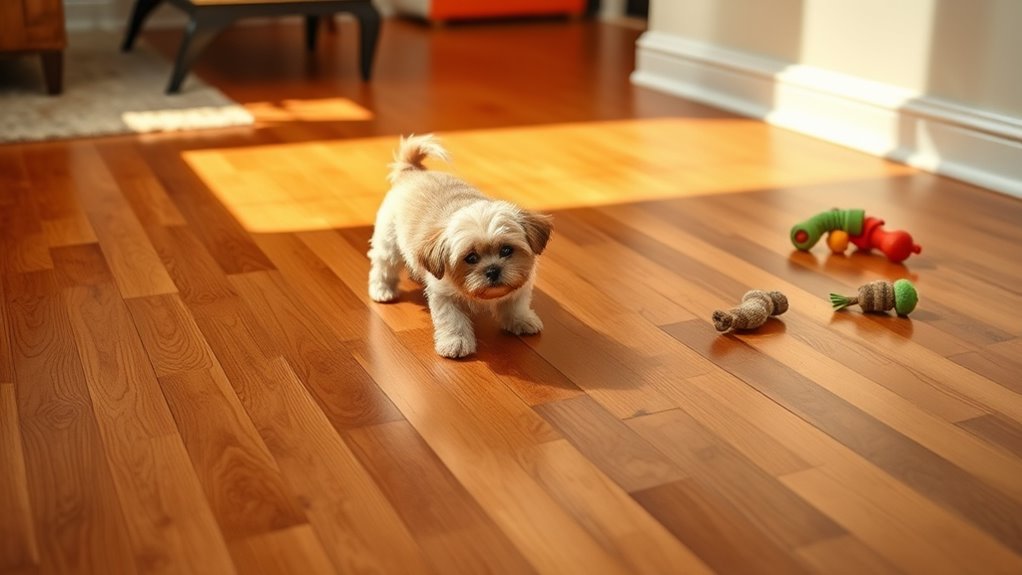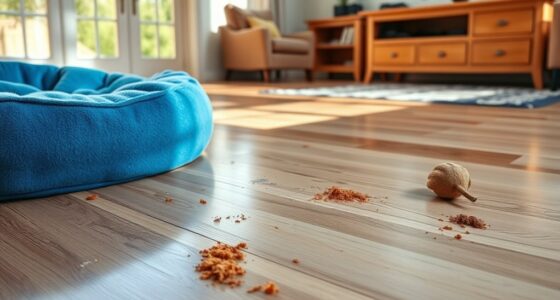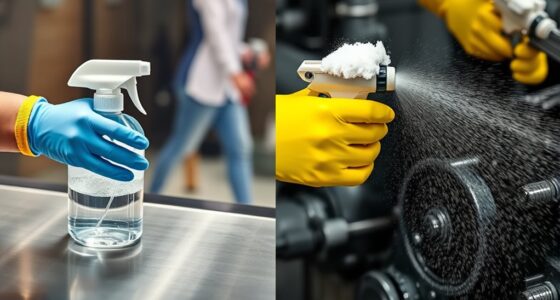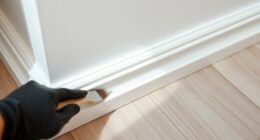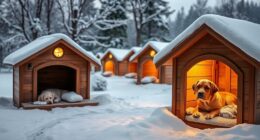Quickly and safely clean pet messes on sealed hardwood by gently removing solids with a disposable towel, then blot liquids with a soft cloth—avoid scrubbing or pressing too hard. Use a pH-neutral, odor-free cleaner sprayed lightly onto the affected area, and wipe with a microfiber cloth along the wood grain. Dry thoroughly to prevent damage, and you’ll maintain your floor’s beauty and freshness. Discover more tips to keep your floors pristine and odor-free as you continue.
Key Takeaways
- Gently remove solids with disposable towels, avoiding pressing or scrubbing to prevent scratches.
- Blot liquids immediately with a clean, absorbent cloth to prevent spreading and embedding.
- Use pH-neutral, odor-free cleaners specifically designed for sealed hardwood floors.
- Wipe in the direction of the wood grain and dry thoroughly to prevent moisture damage.
- Regular cleaning combined with pet training reduces accidents and maintains a fresh, healthy environment.

Have you ever wondered how to handle pet messes on your hardwood floors? It’s a common concern for pet owners who want to keep their homes clean and safe. When messes happen, quick and effective cleanup is essential to prevent stains, odors, and damage. The key is understanding how to clean properly without harming your sealed hardwood, while also addressing the root causes of accidents. Dog training plays a pivotal role here, helping your pet learn where and when to go, reducing the frequency of messes. Consistent training creates a calmer, more predictable routine, making cleanup easier and less stressful for everyone. Plus, a well-trained dog is less likely to have accidents in inappropriate places, minimizing the need for harsh cleaning methods that could damage your floors.
Proper training and quick cleanup protect your hardwood floors and create a healthier home environment.
When a pet mess occurs, start by gently picking up any solids with a disposable paper towel or plastic bag. Avoid pressing too hard or scrubbing aggressively, as that can scratch the sealed surface. For liquids, blot the area immediately with a clean, absorbent cloth or paper towel—don’t rub, because that can spread the mess and embed it deeper into the grain of the wood. Once the bulk of the mess is removed, use a cleaning solution specifically designed for sealed hardwood floors. Opt for a pH-neutral cleaner that’s safe and odor-free, helping with allergy prevention by reducing airborne allergens and irritants that can worsen allergies.
It’s essential to clean thoroughly but gently. Spray the cleaner onto the affected area, then wipe with a microfiber cloth or soft mop, working in the direction of the wood grain. Avoid over-wetting the floor, as excess moisture can seep into seams and cause damage over time. After cleaning, dry the area completely with a soft towel to prevent water spots or warping. Regularly cleaning your floors with a gentle, allergy-friendly solution keeps the surface pristine and reduces dust, pet dander, and other allergens that can trigger allergy symptoms. This approach not only maintains the beauty of your hardwood but also creates a healthier environment for everyone.
In addition to immediate cleanup, consider implementing a routine that combines dog training with preventive measures like designated potty spots or frequent walks. This will help reduce the chances of future messes and make cleaning less frequent and less stressful. When you stay consistent with your cleaning and training efforts, your hardwood floors stay beautiful, your home remains allergy-friendly, and your pet learns good habits. Managing pet messes on sealed hardwood isn’t just about cleaning—it’s about creating a safe, healthy space where both you and your pet can thrive comfortably.
Frequently Asked Questions
Can Sealed Hardwood Floors Be Damaged by Cleaning Agents?
Sealed hardwood floors can be damaged by cleaning agents if you use harsh chemicals or abrasive cleaners. These substances can strip the sealant, leading to scratches or dullness over time. To keep your floors safe, stick to gentle, pH-balanced cleaners specifically designed for hardwood. Avoid harsh chemicals and abrasive cleaners, and always test a small area first. Proper, gentle cleaning preserves the floor’s finish and durability.
How Often Should I Deep Clean My Sealed Hardwood Floors?
Think of deep cleaning your sealed hardwood floors like giving your car a thorough wash—done regularly, it keeps everything shining. You should deep clean about once every 3 to 6 months, depending on foot traffic and pet activity. Incorporate this into your seasonal cleaning routine and routine maintenance to prevent dirt buildup, safeguard your floors, and keep them looking beautiful. Regular deep cleaning guarantees your floors stay in top condition for years.
Are There Specific Products to Prevent Future Pet Messes?
Yes, you can use pet proof sprays to create a barrier that discourages pets from soiling your floors again. Applying these sprays regularly helps prevent accidents and keeps your sealed hardwood looking its best. Additionally, placing protective mats in high-traffic or accident-prone areas offers extra security. Combining pet proof sprays with protective mats effectively reduces future pet messes, making cleanup easier and maintaining a clean, odor-free environment for your home.
What Should I Do if My Pet’s Stain Persists?
If your pet’s stain persists, don’t worry—about 60% of pet owners face this issue. To tackle it, focus on effective pet stain removal and odor elimination. Use a enzymatic cleaner designed for hardwood floors, applying it thoroughly to break down the stain and neutralize odors. Allow it to sit as directed, then gently blot. Repeat if needed, ensuring your floor stays fresh and clean.
Can Sealed Hardwood Floors Be Refinished After Pet Damage?
Yes, you can refinish sealed hardwood floors after pet damage. In fact, refinishing sealed hardwood is a great way to repair pet damage and restore your floor’s appearance. The process involves sanding down the damaged surface and applying a fresh coat of sealant or finish. Just make certain you choose a pet-safe, odor-free finish to keep your home healthy and prevent future damage.
Conclusion
While a quick cleanup keeps your hardwood pristine, lingering pet messes can threaten its beauty and your peace of mind. You want to cherish your home’s warmth, yet the stains and odors remind you of accidents you’d rather forget. But with the right tools and gentle care, you can restore your floor’s shine and keep your bond with your pet strong. Don’t let messes steal the comfort you’ve worked so hard to create—clean confidently, love endlessly.
